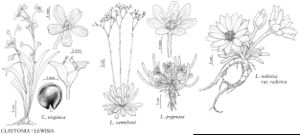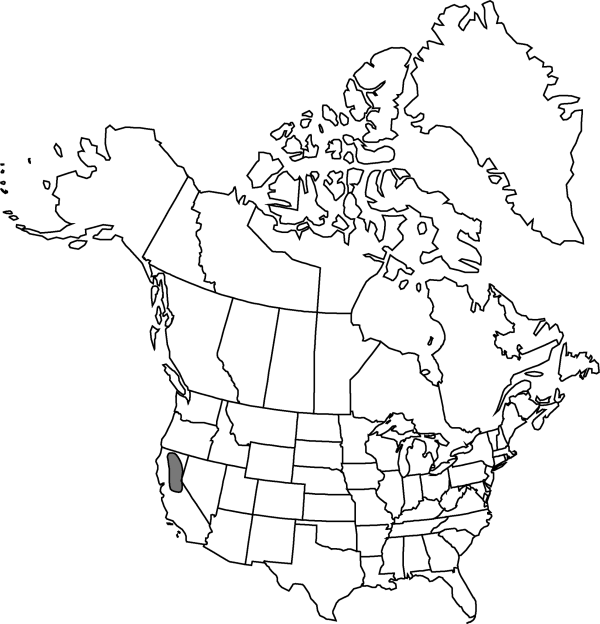Difference between revisions of "Lewisia cantelovii"
Leafl. W. Bot. 3: 139. 1942.
FNA>Volume Importer |
FNA>Volume Importer |
||
| Line 26: | Line 26: | ||
|elevation=400-1300 m | |elevation=400-1300 m | ||
|distribution=Calif. | |distribution=Calif. | ||
| − | |discussion=<p>B. L. Davidson (2000) summarized evidence for taxonomic recognition of plants from populations in the extreme southern (El Dorado and Placer counties) and northern (Shasta County) portions of the range as distinct varieties. The southern populations have been recognized as Lewisia serrata and are distinguished by the combination of rounded to obtuse leaf apices, shorter stems (10–25 cm), longer pedicels (3–8 mm), and shorter petals (5–6 mm). The northern populations are distinguished by the combination of longer stems (30–60 cm) and scarcely glandular or eglandular margin teeth.</p> | + | |discussion=<p>B. L. Davidson (2000) summarized evidence for taxonomic recognition of plants from populations in the extreme southern (El Dorado and Placer counties) and northern (Shasta County) portions of the range as distinct varieties. The southern populations have been recognized as <i>Lewisia</i> serrata and are distinguished by the combination of rounded to obtuse leaf apices, shorter stems (10–25 cm), longer pedicels (3–8 mm), and shorter petals (5–6 mm). The northern populations are distinguished by the combination of longer stems (30–60 cm) and scarcely glandular or eglandular margin teeth.</p> |
|tables= | |tables= | ||
|references= | |references= | ||
| Line 50: | Line 50: | ||
|publication year=1942 | |publication year=1942 | ||
|special status= | |special status= | ||
| − | |source xml=https://jpend@bitbucket.org/aafc-mbb/fna-data-curation.git/src/ | + | |source xml=https://jpend@bitbucket.org/aafc-mbb/fna-data-curation.git/src/8f726806613d60c220dc4493de13607dd3150896/coarse_grained_fna_xml/V4/V4_961.xml |
|genus=Lewisia | |genus=Lewisia | ||
|species=Lewisia cantelovii | |species=Lewisia cantelovii | ||
Revision as of 17:32, 18 September 2019
Taproots gradually ramified distally. Stems procumbent to suberect, 10–50(–60) cm. Leaves: basal leaves evergreen, sessile or abruptly or gradually narrowing to broad petiole, blade narrowly obovate to spatulate, flattened, (2–)2.5–8(–14) cm, margins finely toothed to coarsely triangular-toothed, apex truncate, emarginate, retuse, or rounded; cauline leaves absent, or alternate or in suprabasal rosettes, similar to but smaller than basal leaves and intergrading with bracts, 3–12 mm. Inflorescences loosely paniculate cymes, 30–100-flowered; bracts several, alternate or opposite proximally, 2 at each flowering node distally, ovate, obovate, or elliptic, 1–4 mm, margins glandular-toothed, apex acute. Flowers pedicellate, not disarticulate in fruit; sepals 2, suborbiculate to broadly elliptic, 2–3 mm, herbaceous at anthesis, margins glandular-toothed, rarely eglandular, apex rounded to truncate; petals 5–7, white to pale pink, veins darker pink, elliptic, elliptic-ovate to elliptic-obovate, 5–9 mm; stamens 5–6; stigmas 3; pedicel 0.3–8 mm. Capsules 3 mm. Seeds 1–3, 1.2–1.5 mm, shiny, ± smooth. 2n = 28.
Phenology: Flowering late spring–summer.
Habitat: Usually on shaded, moist, rocky canyon and ravine walls
Elevation: 400-1300 m
Discussion
B. L. Davidson (2000) summarized evidence for taxonomic recognition of plants from populations in the extreme southern (El Dorado and Placer counties) and northern (Shasta County) portions of the range as distinct varieties. The southern populations have been recognized as Lewisia serrata and are distinguished by the combination of rounded to obtuse leaf apices, shorter stems (10–25 cm), longer pedicels (3–8 mm), and shorter petals (5–6 mm). The northern populations are distinguished by the combination of longer stems (30–60 cm) and scarcely glandular or eglandular margin teeth.
Selected References
None.

